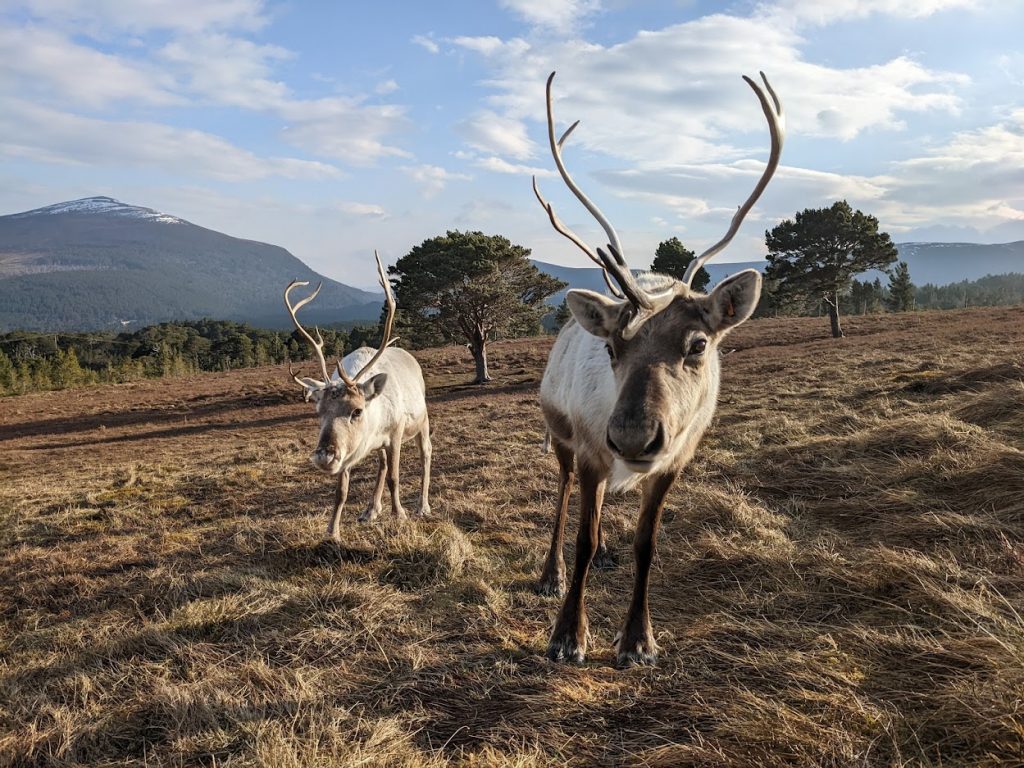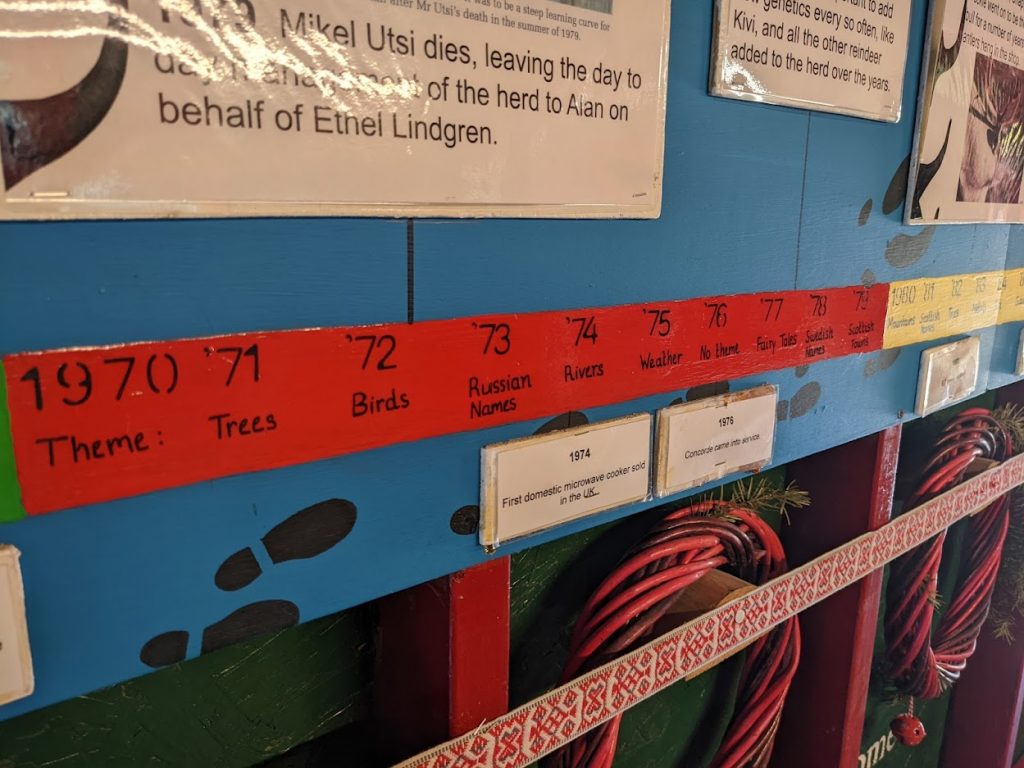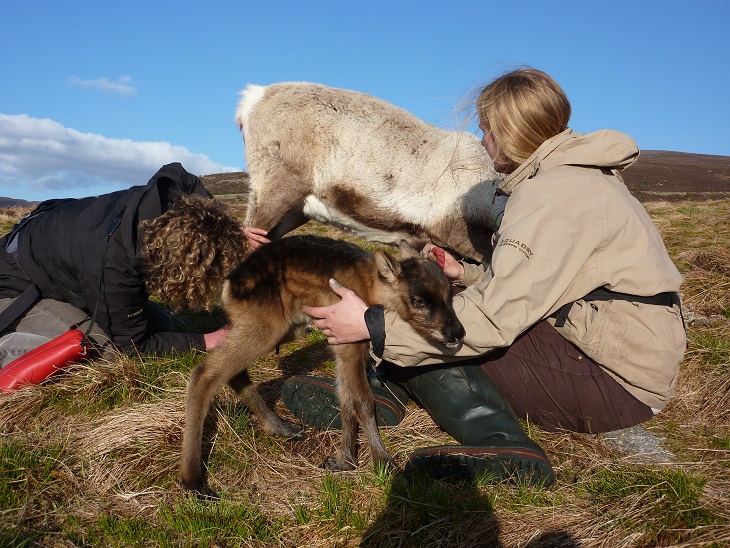It is now officially calving season!! As I write this blog it is the last day of April, and we already have two new calves in our ranks. All the calves will be named in September, as is always the case. In fact, every Cairngorm reindeer has a name, and this follows a designated theme each year. Whilst we have not yet decided on the theme for the 2022 calves, we will often be asked about previous themes. In this blog I’ll describe previous themes. Feel free to leave your ideas for themes in our comments section.
2021: Hats (blue coloured tag) – e.g., Fez, Sombrero, Trilby.
2020: Peas, seeds & beans (grey) – Chickpea, Mushy, Sunflower.
2019: European cities & towns (brown) – Berlin, Kiruna, Florence.
2018: Detectives, inspectors & spies (orange) – Marple, Bond, Poirot.
2017: Poets & authors (hot pink) – Dr. Seuss, Kipling, Christie.
2016: Ancient civilizations (green) – Spartan, Celt, Inca.
2015: Scottish hill races (white) – Ochil, Morven, Scolty.
2014: Bays, seas & oceans (purple) – none remaining alive.
2013: Cheeses (yellow) – Brie, Camembert, Feta.
2012: The year ‘2012’ was the theme (black) – Olympic, Diamond, Torch.
2011: Games & pastimes (red) – Jenga, Scrabble, Origami.
2010: Bugs & beasties (blue) – Caterpillar, Spider, Ladybird.
2009: Cakes, puddings & desserts (pink) – Strudel, Pavlova, Hobnob.
2008: Antlered & horned animals (orange) – Moose, Gazelle, Ibex.
2007: A theme centred around all things ‘Green’ (green) – Fern, Fly.
2006: Popstars (silver) – Elvis, Enya, Lulu.
2005: Countries (yellow) – Malawi.






So, there you have it, that is a list of the naming themes (with the corresponding tag colour and some examples of reindeer names) that are currently in circulation with our reindeer. Now, when you visit again you may have a better idea of how old the reindeer you are feeding may be. Although, as you can see, some colours are repeated which can cause confusion. For example, if you see an orange tag, you may not know if this reindeer was born in 2008 or 2017. Well, each reindeer also has a number on their tag and this number corresponds to the reindeer name on our systems. It is a legal requirement to have a tag on any animal that is transported within the U.K., so we’ve made it work for us with specific colours and numbers that help us identify the reindeer if required.

It is worth noting that we also have just under 10 male reindeer still with us that were born in Sweden between the years of 2009 and 2011 and brought to Scotland to provide new genetics for our herd. These older boys were named individually and not within a theme. Spike, Caesar, Houdini, Bovril, and Hook are some examples of these boys’ names, and they have a range of numbers and colours in their ear tags.

It is not just ‘the Swedes’ that have names that don’t fit into a theme. Occasionally we will get reindeer where a nickname from early on in their life appears to stick and stay with the reindeer. Holy Moley, our television superstar, had such an eventful initial few days to her life that one herder exclaimed ‘holy moley!’ after being informed of events (she fell down a hole in a boulder field). Svalbard is another example. He was supposed to be called Meccano to fit in with the 2011 naming theme of Games & pastimes, but that name never stuck due to him looking incredibly alike a Svalbard reindeer (small and dumpy). Hamish is a final example of being an exception to the naming rule. Hamish was born in 2010 and unfortunately wasn’t being fed by his mother. This led to him being bottle-fed by the herders for the first part of his life so that he could grow into a big, strong Scottish reindeer and as such was given a big, strong Scottish name…Hamish.

Previous themes, prior to 2005, yielded some great names. We have been naming the reindeer after a theme since 1971. It has gotten to the point where a lot of the more obvious themes have been chosen by now. Some examples of previous themes are: Musical instruments & genres (2000), Colours (1999), Sweets & chocolate bars (1998), Fruits & nuts (1992), Wines & whiskies (1991), Herbs & spices (1988), Scottish islands (1987), Fish (1984), Trees (1982 & 1971), Mountains (1980), Weather (1975 & 1996), and Birds (1972). Before 1971, Mr. Utsi and Dr. Lindgren (the original owners of the Cairngorm Reindeer Herd) named the male reindeer after Scottish places (e.g., Aviemore) and the female reindeer had human names (e.g., Mary).

In our office we have a folder with naming theme suggestions collected throughout the years. I have just had a look through it and some of the suggested themes are: Vegetables, Ice creams & lollies, Mushrooms & toadstools, Condiments & spreads, Indian foods, Teas & coffees, Cocktails (as you can see, we enjoy our food and drink here), Disney side-kick characters, Mountain ranges, Sea creatures, Gods & goddesses, Rivers of the world, and Dances. Who knows what themes 2022 and beyond will bring? Once we decide, the theme and each reindeer name are revealed to adopters in the autumn newsletter.
Ben















